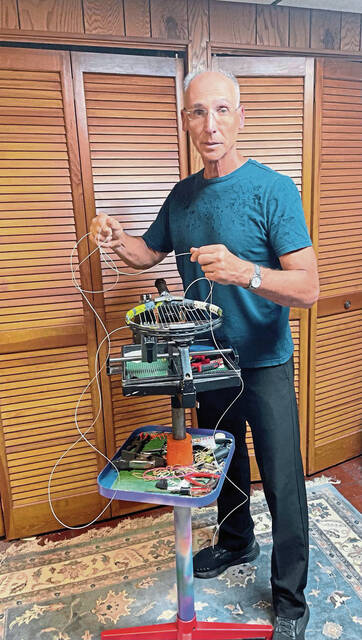https://mirror.triblive.com/local/north-allegheny/mccandless-man-has-made-a-career-out-of-restringing-tennis-rackets/
McCandless man has made a career out of restringing tennis rackets

Anton Constantino may know a thing or two about tennis rackets, having restrung more than 25,000 of them.
Restringing a racket is something that every professional or avid player knows keeps their game tight, according to Constantino — and he knows just how to do it.
“A pro can tell the difference between a freshly stringed racket and one already used,” Constantino said.
Restringing a racket is the process of removing the old strings and stringing in new ones.
The McCandless resident said a racket should be restrung every 40 hours of play, otherwise it loses its elasticity.
He bought his first stringing machine around 1979, and has strung some notable players in his career.
Sally Gibson, who has worked at the Oxford Athletic Club in Pine for more than 20 years, runs the tennis tournaments there and organizes the adult tennis leagues. About 20 years ago, she organized the women’s challenger tournament there featuring $75,000 prize money. Russian tennis champion Maria Sharapova was one of the participants and Constantino strung about 10 to 12 rackets for her, Gibson said.
“Anton was the exclusive stringer for the tournament and that man strung literally 1,000 rackets in that week he was here,” she said. “His fingers were probably bleeding.”
Gibson said getting the string right is important.
“Every player has a different preference. How loose or firm they want the string determines how they want it to feel and the power they get,” she said.
Even when someone isn’t sure on what they need, Gibson said “Anton is pretty good at determining what’s best for people.”
He has also strung rackets for American tennis champion Chris Evert, who was here for a promotional event in the 1990s when he was working at The Racquet Club of Monroeville, and for Marty Hogan, who at the time was at the top of the racquetball world, Constantino said.
However, it’s quite arduous work, according to Whitney Snyder, head tennis pro at the Butler Country Club, part-time tennis pro at the Oxford Athletic Club and the varsity coach at Sewickley Academy.
“It’s very tedious,” said Snyder, who added it’s vital to have a well-strung racket.
Using an older or improperly strung racket may lead to “tennis elbow,” or an elbow injury, because of the lack of flexibility and “no pop,” Snyder said.
Rackets’ strings have to be measured and cut and then fit into tiny holes, ensuring the tension is accurate, which makes it no simple job, Snyder said.
But he said Constantino is dependable, efficient and fast.
“His integrity is A-plus,” said Snyder. “He’s a true professional. He’s very reliable.”
Constantino said tension can be different for each type of player — he tighter the string the more control, the looser the string, the less control.
Different strings may include polyester, or multifilament.
Constantino said the first racket he did took him six hours, now he can do them in about 25 minutes. If it’s a rush job, he’ll get it done in 15 minutes.
Constantino was certified with the United States Racquet Stringers Association in Cleveland in 1990 by Bud Nihiser, a former stringer for Head/Penn sports. However, Constantino hasn’t paid dues so he is currently not a member, simply because he’s “strung so many frames there isn’t anything new they could tell me.”
Constantino is semi-retired working the front desk and as a tennis stringer at the Oxford Athletic Club. He has also worked at clubs in downtown Pittsburgh. In addition to tennis and racquetball rackets, he’s strung squash and a few badminton rackets as well.
As far as his own sport, Constantino’s preference is racquetball. This is where he met his wife, Linda, who went to his racquetball class because she heard he was offering discount lessons. They have four children.
She likes to joke with people saying she got him at discount, he said.
Copyright ©2025— Trib Total Media, LLC (TribLIVE.com)
